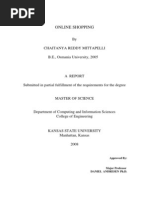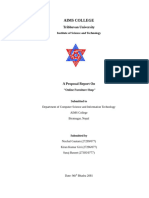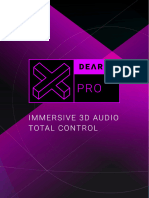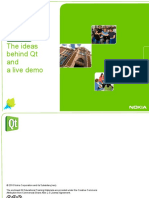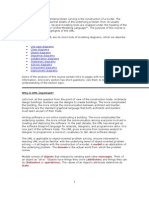report
report
Uploaded by
yashdhawale24Copyright:
Available Formats
report
report
Uploaded by
yashdhawale24Copyright
Available Formats
Share this document
Did you find this document useful?
Is this content inappropriate?
Copyright:
Available Formats
report
report
Uploaded by
yashdhawale24Copyright:
Available Formats
Annexure A
CERTIFICATE
This is to certify that Mr. Yash Dhawale, Krushna Bargaje, Aryakumar Gaikwad, Shreyash Dhawale
From Pimpri Chinchwad Polytechnic college having Enrollment No 2200560068,
2200560165, 2200560170, 2200560215 has completed Project Planning Report having AR
Shopping Assistant in group consisting of 4 candidate under the guidance of the Faculty Guide.
Name and Signature of Guide: Name and Signature of HOD:
CHAPTER 1:
INTRODUCTION AND BACKGROUND OF THE INDUSTRY
OR USER BASED PROBLEM
1.1 Motivation
The motivation for an AR Shopping Assistant is to enhance the online shopping
experience by allowing users to visualize products in their real-world environment.
AR enables customers to “place” virtual models of items like furniture or decor in
their spaces, helping them understand how products will look and fit. This
interactive approach increases confidence in purchasing decisions by reducing
uncertainties that arise from viewing only static images. By simulating an in-store
experience, AR helps lower return rates, improve customer satisfaction, and boost
engagement. Ultimately, it provides a more immersive, informative, and enjoyable
online shopping experience.
1.2 Background
Growth of E-commerce: As online shopping becomes more popular, its limitations—
like the inability to physically interact with products—are becoming more noticeable.
Lack of Physical Interaction: Traditional online platforms don’t allow users to touch,
see, or feel items, leading to uncertainty about product suitability in real life.
Role of AR in Bridging the Gap: AR technology addresses this gap by allowing users
to place virtual products in their actual space, offering a more realistic view of items.
'Try Before You Buy' Experience: With AR, customers can visualize how products
look and fit in their environment, helping them make more confident purchasing
decisions.
Department of Computer Engineering, PC Polytechnic
1.3 Need
• Enhanced Visualization: AR enables users to see products in their real-world
environment, helping them assess size, fit, and style more accurately before purchase.
• Improved User Experience: By providing an interactive and immersive shopping
experience, AR makes online shopping more engaging and enjoyable, increasing
customer satisfaction.
• Reduced Purchase Uncertainty: With AR, customers can better understand how a
product will look or fit in their space, reducing the hesitation and uncertainty often
experienced in traditional online shopping.
• Decreased Return Rates: By giving users the ability to try products virtually, AR can
reduce the likelihood of returns due to mismatched expectations, saving time and
money for both buyers and sellers.
• Competitive Advantage: As AR becomes more popular, e-commerce businesses can
differentiate themselves by offering cutting-edge technology that enhances the
shopping experience, attracting more customers.
• Personalized Shopping: AR allows for customization and personalization, such as
trying different colors, sizes, or styles in real-time, which helps create a tailored
shopping experience for each customer
PC Polytechnic, Department of Computer Engineering
CHAPTER 2
LITERATURE SURVEY FOR PROBLEM IDENTIFICATION
AND SPECIFICATION
2.1 Existing Systems
Paper Title :
"Augmented Reality in Retail: A Review of Recent Developments"
• Authors: M. H. Kim, S. H. Kim, and J. S. Park
• Publication: International Journal of Retail & Distribution
Management, vol. 48, no. 2, pp. 132-147, 2020
• Summary: This review article explores the recent advancements in
AR technology and its applications in the retail sector. It discusses
how AR enhances the shopping experience through virtual try-ons,
interactive product displays, and personalized recommendations.
• Link: International Journal of Retail & Distribution Management
Paper Title :
"The Impact of Augmented Reality on Consumer Behavior in Retail"
• Authors: A. T. D. Mollaoglu and S. F. Yoon
• Publication: Journal of Retailing and Consumer Services, vol. 58, pp. 102-109,
2024
• Summary: This study examines how AR influences consumer
behavior, focusing on how virtual product visualization and interactive
features affect purchasing decisions and shopping satisfaction.
• Link: Journal of Retailing and Consumer Services
PC Polytechnic, Department of Computer Engineering
Paper Title :
"Augmented Reality Applications in Retail: The Role of Mobile and
Wearable Technologies"
• Authors: J. H. Lee, H. J. Kim, and M. K. Cho
• Publication: IEEE Transactions on Consumer Electronics, vol. 66,
no. 3, pp. 319- 326, 2020
• Summary: This paper discusses various AR technologies used in retail,
including mobile applications and wearable devices. It provides insights
into how these technologies are integrated into retail environments to
enhance consumer engagement and streamline shopping processes.
• Link: IEEE Transactions on Consumer Electronics
Paper Title :
"Consumer Perceptions of Augmented Reality Shopping: A Comparative
Study of Traditional and Online Retail"
• Authors: C. C. Yang and K. L. Lee
• Publication: Journal of Retailing and Consumer Services, vol. 53, pp. 101-109,
2020
• Summary: This paper compares consumer perceptions of AR shopping
in traditional brick-and-mortar stores versus online platforms. It
evaluates how AR influences shopping experiences and purchasing
behavior in different retail contexts.
• Link: Journal of Retailing and Consumer Services
PC Polytechnic, Department of Computer Engineering
2.2 Description
There are below Objective
• Improve product visualization
• User engagement
• Personalized recommendations.
2.3 Application:
Designed for consumers who want a more interactive online shopping
experience.
Advantages
▪ Higher engagement
▪ Improved decision-making
▪ Fewer returns
Disadvantages
• Needs compatible hardware
• Requires strong internet connection
PC Polytechnic, Department of Computer Engineering
CHAPTER 3
DETAILED METHODOLOFY OF SOLVING THE IDENTIFIED
PROBLEM WITH ACTION PLAN
3.1 Project Modules
• Visualization Module: This module allows users to view products in 3D,
enhancing their ability to see how items would look in their own space
before purchasing.
• Recommendation Module: It analyzes user preferences and browsing
history to suggest relevant products, improving the shopping experience
by offering personalized recommendations.
• UI Module: A user-friendly interface ensures easy navigation through
the platform, allowing customers to browse, select, and interact with
items seamlessly.
• Feedback Module: This module collects user feedback on the AR
experience and product satisfaction, helping to improve future
interactions and product offerings.
• Notification Module: It keeps users informed by sending timely alerts
about new arrivals, promotions, and product updates, ensuring they don't
miss out on key offers.
PC Polytechnic, Department of Computer Engineering
3.2 Input and Output:
Visualization Module
• Input: Product data
• Output:Visualizatin
Recommendation Module
• Input: Preferences
• Output: Suggestions
UI Module
• Input: Interactions
• Output: Interface
Feedback Module
• Input: Feedback
• Output: Insights
PC Polytechnic, Department of Computer Engineering
3.3 Flow chart
Figure 1. Flow chart
PC Polytechnic, Department of Computer Engineering
Data Flow Diagram
3.4 Data Flow Diagram
Figure 2. DFD Diagram
3.4 DFD-ADMIN
Figure 3. DFD-ADMIN Diagram
PC Polytechnic, Department of Computer Engineering
3.5 DFD-CLIENT
Figure 4. DFD-CLIENT Diagram
3.6 Project Schedule:
PC Polytechnic, Department of Computer Engineering
You might also like
- Digital Wealth A Guide To Making Money With Digital ProductsFrom EverandDigital Wealth A Guide To Making Money With Digital ProductsNo ratings yet
- 15.1.cyber Security Implementation Guidelines For Instrument Control Systems Rev 00Document22 pages15.1.cyber Security Implementation Guidelines For Instrument Control Systems Rev 00Ravi JankarNo ratings yet
- Effects of 3D Virtual Try-On On Online Sales and CDocument13 pagesEffects of 3D Virtual Try-On On Online Sales and CShakil AhmedNo ratings yet
- Sachin Project Report FinalDocument58 pagesSachin Project Report FinalABHIMUSIXNo ratings yet
- Iot Black BookDocument27 pagesIot Black BookmitshuaNo ratings yet
- Influence of Product Features On Consumer Attitude: A Study of Smartphone in Pakistan'Document19 pagesInfluence of Product Features On Consumer Attitude: A Study of Smartphone in Pakistan'krkamranpNo ratings yet
- Online Shopping 20Document32 pagesOnline Shopping 20DR nagar gamerNo ratings yet
- Online ShoppingDocument32 pagesOnline ShoppingManasvi Mehta50% (18)
- Project ReportDocument26 pagesProject Reportkarnav502No ratings yet
- Research On B2B2C E-Commerce Website Design 2018Document6 pagesResearch On B2B2C E-Commerce Website Design 2018Danush SNo ratings yet
- Effect of 3D Product Presentation On Consumer Preference in E-CommerceDocument7 pagesEffect of 3D Product Presentation On Consumer Preference in E-CommerceRez KNo ratings yet
- IJCRTO020017Document4 pagesIJCRTO020017mkvidhathaNo ratings yet
- PROJECT TITLE: E-Commerce Site (Agriculture Product Recommendation System)Document13 pagesPROJECT TITLE: E-Commerce Site (Agriculture Product Recommendation System)San DipNo ratings yet
- Prof - Ramkhrishana More: " " Submitted byDocument35 pagesProf - Ramkhrishana More: " " Submitted byAmolNo ratings yet
- BUSINESS DIARY - An Interactive and Intelligent Platform For SME'sDocument3 pagesBUSINESS DIARY - An Interactive and Intelligent Platform For SME'srahul sharmaNo ratings yet
- JETIR2105567Document3 pagesJETIR2105567Shalini ShaluNo ratings yet
- A Major Project Report On "Online Shopping Cart"Document53 pagesA Major Project Report On "Online Shopping Cart"Brenda CoxNo ratings yet
- FYP-Proposal-3D Modeling Ecommerce Store With AI Recommendation (Final)Document18 pagesFYP-Proposal-3D Modeling Ecommerce Store With AI Recommendation (Final)Imran KhanNo ratings yet
- B6 ReportsDocument14 pagesB6 ReportsVishal ChavanNo ratings yet
- rm final juryDocument14 pagesrm final juryAbhiroop BiswasNo ratings yet
- Blackbook Online Furniture Shop (Simplified)Document84 pagesBlackbook Online Furniture Shop (Simplified)Chumma ChummaNo ratings yet
- Online Shopping SRSDocument27 pagesOnline Shopping SRSنعمان ملکNo ratings yet
- Product Intern AssingmentDocument2 pagesProduct Intern Assingmentmallidinavya635No ratings yet
- Consumers' Purchase Behavior Preference in E-Commerce Platform Based On Data Mining AlgorithmDocument7 pagesConsumers' Purchase Behavior Preference in E-Commerce Platform Based On Data Mining AlgorithmIbnu PrayogiNo ratings yet
- Project Report: Submitted in Partial Fulfillment of The Degree of Masters of Business Administration Session (2016-2017)Document69 pagesProject Report: Submitted in Partial Fulfillment of The Degree of Masters of Business Administration Session (2016-2017)Shahrukh Khan100% (1)
- Latest E - Commerce Website DocumentaionDocument51 pagesLatest E - Commerce Website Documentaionkumthekarsachin00No ratings yet
- Wa0022.Document33 pagesWa0022.flerkinnNo ratings yet
- Karhik G.morabad Synopsis DesertationDocument4 pagesKarhik G.morabad Synopsis DesertationKarthik MorabadNo ratings yet
- IJRPR HomeDecorMarketplaceDocument5 pagesIJRPR HomeDecorMarketplaceYousuf Ansari IFNo ratings yet
- Ijarcce 2023 124187Document5 pagesIjarcce 2023 124187JonathanNo ratings yet
- Synopsis Format 23-24Document20 pagesSynopsis Format 23-24Aditya Kumar mehtaNo ratings yet
- 6630 46994 1 PBDocument11 pages6630 46994 1 PBFany MillenNo ratings yet
- proposalnewDocument16 pagesproposalnewnischalgautam113No ratings yet
- Socionomics:The Way Business Transforms With Social MediaDocument8 pagesSocionomics:The Way Business Transforms With Social MediaSusmithaUnniNo ratings yet
- E RetailingDocument58 pagesE RetailingRitesh PandeyNo ratings yet
- Smart Fashion Recommender Application 90Document153 pagesSmart Fashion Recommender Application 90sowmiyasrikanth107No ratings yet
- Final Report CBDocument26 pagesFinal Report CBManoj JhawarNo ratings yet
- Comp1682 001196959 ReportDocument8 pagesComp1682 001196959 ReportHải ĐăngNo ratings yet
- Customer Sentiment Based Online Grocery Recommendation EngineDocument6 pagesCustomer Sentiment Based Online Grocery Recommendation EngineInternational Journal of Innovative Science and Research TechnologyNo ratings yet
- Computer Science Jefrin BenoDocument46 pagesComputer Science Jefrin BenoJefrin BenoNo ratings yet
- Siwangi Shaw.. - RemovedDocument35 pagesSiwangi Shaw.. - RemovedAman ShawNo ratings yet
- Mini Project ReportDocument46 pagesMini Project ReportAyushi SharmaNo ratings yet
- Online Shopping SystemDocument16 pagesOnline Shopping SystemAniket SangaiNo ratings yet
- Mini Project ReportDocument19 pagesMini Project ReportÁQUANo ratings yet
- E-Commerce and Digital MarketsDocument10 pagesE-Commerce and Digital MarketsNISHANTH RAMAKRISHNAN (DA2252305010147)No ratings yet
- Sentimence AnalysisDocument6 pagesSentimence Analysisneerajaav02No ratings yet
- Industrial Training Report On (App in Flutter) : Shopping E-CommerceDocument40 pagesIndustrial Training Report On (App in Flutter) : Shopping E-CommerceNISHANTKUMAR PATELNo ratings yet
- ICINC201749Document7 pagesICINC201749sixfour320No ratings yet
- Synopsis On Effectiveness of Online MarketingDocument10 pagesSynopsis On Effectiveness of Online MarketingBhavesh BhartiNo ratings yet
- Paper 18Document9 pagesPaper 18shreyashshete02315No ratings yet
- Akshita Sharma MBADocument48 pagesAkshita Sharma MBASamayra KhanNo ratings yet
- Innovative Industrial Design: C. Information Preservation Is Not EasyDocument3 pagesInnovative Industrial Design: C. Information Preservation Is Not EasyAJ KangNo ratings yet
- Pulsebot AI - Research Paper, Dec 24'Document5 pagesPulsebot AI - Research Paper, Dec 24'helloNo ratings yet
- A Study On Customer Attitute Towards Online Shopping: Vishnu Priya.BDocument23 pagesA Study On Customer Attitute Towards Online Shopping: Vishnu Priya.BRajesh KsNo ratings yet
- 21 CustomerSatisfactionDocument14 pages21 CustomerSatisfactionJeevan JeevaNo ratings yet
- ChaptersDocument58 pagesChaptersAysha KabeerNo ratings yet
- MONETIZE CLOUD & AI: From technology innovation to business excellenceFrom EverandMONETIZE CLOUD & AI: From technology innovation to business excellenceNo ratings yet
- SP Once RshipDocument2 pagesSP Once Rshipyashdhawale24No ratings yet
- 22516-1Document2 pages22516-1yashdhawale24No ratings yet
- AJP PracticalExamList 24 25Document4 pagesAJP PracticalExamList 24 25yashdhawale24No ratings yet
- YASHDocument17 pagesYASHyashdhawale24No ratings yet
- Format 4 YyyDocument1 pageFormat 4 Yyyyashdhawale24No ratings yet
- Sponsorship LetterDocument2 pagesSponsorship Letteryashdhawale24No ratings yet
- Advandced JavaDocument199 pagesAdvandced Javayashdhawale24No ratings yet
- EST CT-1 Ques. Bank UNIT-3 MCQsDocument5 pagesEST CT-1 Ques. Bank UNIT-3 MCQsyashdhawale24No ratings yet
- Chapter 06 ServletDocument76 pagesChapter 06 Servletyashdhawale24No ratings yet
- Python - Revision TourDocument63 pagesPython - Revision TourDeni NikilanNo ratings yet
- Immediate Download Getting Started With Unity 2018 A Beginner S Guide To 2D and 3D Game Development With Unity 3rd Edition Edward Lavieri Ebooks 2024Document62 pagesImmediate Download Getting Started With Unity 2018 A Beginner S Guide To 2D and 3D Game Development With Unity 3rd Edition Edward Lavieri Ebooks 2024shaidarekhi100% (6)
- Cse 111Document9 pagesCse 111VaibhavNo ratings yet
- U R T For A Supervisory Control and Data Acquisition (SCADA) Process Control SystemDocument66 pagesU R T For A Supervisory Control and Data Acquisition (SCADA) Process Control SystemSurangaGNo ratings yet
- Introduction To Digital ApplicationsDocument2 pagesIntroduction To Digital ApplicationsFergal CantonNo ratings yet
- Chapter 9. Main Memory (Updated)Document58 pagesChapter 9. Main Memory (Updated)마날루 가브리엘학부생No ratings yet
- City EuropeDocument40 pagesCity EuropeXinyao QianNo ratings yet
- SCM FinalDocument28 pagesSCM FinalAPS PlacementsNo ratings yet
- Dearvr Pro ManualDocument46 pagesDearvr Pro ManualJosep BlascoNo ratings yet
- Jboss Fuse TutorialDocument61 pagesJboss Fuse TutorialZoran HristovNo ratings yet
- ABAPTopics v1Document239 pagesABAPTopics v1KARTHIKEYAN VINAYAGAMNo ratings yet
- RFC 1535Document7 pagesRFC 1535NickyNETNo ratings yet
- Get C Programming de Gruyter STEM 1st Edition Yuan Dong PDF Ebook With Full Chapters NowDocument62 pagesGet C Programming de Gruyter STEM 1st Edition Yuan Dong PDF Ebook With Full Chapters Nowjuonysoffiah100% (5)
- Revel For Educators - Revel Integration With Canvas GuideDocument9 pagesRevel For Educators - Revel Integration With Canvas GuideJeffrey Michael AtencioNo ratings yet
- Smart Plant Monitoring System DocumentationDocument48 pagesSmart Plant Monitoring System Documentationkrii24u8No ratings yet
- Computer Hardware Skills Required of ND Secretaries in Imo StateDocument50 pagesComputer Hardware Skills Required of ND Secretaries in Imo StateIyere GiftNo ratings yet
- Brother MFC-9460CDN MFC-9560CDW Color Multifunction Printer Users ManualDocument0 pagesBrother MFC-9460CDN MFC-9560CDW Color Multifunction Printer Users ManualKimberlycustomarmsNo ratings yet
- Unit 4 Chapter 1 Storage and QueryingDocument37 pagesUnit 4 Chapter 1 Storage and Queryingvedantbailmare22No ratings yet
- Purbanchal University College of Information Technology and Engineering Tinkune, KathmanduDocument21 pagesPurbanchal University College of Information Technology and Engineering Tinkune, KathmanduBrish WinstonNo ratings yet
- Iv Unit Data Flow, Behavioral Modeling: EC258 Digital System Design Using VHDLDocument17 pagesIv Unit Data Flow, Behavioral Modeling: EC258 Digital System Design Using VHDLventooesteNo ratings yet
- The Ideas Behind QT and A Live DemoDocument31 pagesThe Ideas Behind QT and A Live DemoNikolas SaridNo ratings yet
- DC Experiment No 8Document5 pagesDC Experiment No 8vu1s2122012No ratings yet
- Untitled 1hmkvhjkmhj5r756Document3 pagesUntitled 1hmkvhjkmhj5r756prv333No ratings yet
- Download full IronPython in Action Michael J. Foord ebook all chaptersDocument55 pagesDownload full IronPython in Action Michael J. Foord ebook all chaptersaguezcheweiNo ratings yet
- Simulink IntroductionDocument21 pagesSimulink IntroductionHien Duong DangNo ratings yet
- Beej's Guide To C ProgrammingDocument750 pagesBeej's Guide To C ProgrammingKrono A.No ratings yet
- The Parts and Appearance of Microsoft Word and Their FunctionsDocument6 pagesThe Parts and Appearance of Microsoft Word and Their FunctionsBenjie BarriosNo ratings yet
- Colchester Alpha Brochure 2021Document7 pagesColchester Alpha Brochure 2021KhalilullahNo ratings yet
- UML DiagramsDocument23 pagesUML DiagramsMeenakshi JanakiramanNo ratings yet







